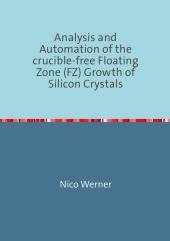 Neuerscheinungen 2014Stand: 2020-02-01 |
Schnellsuche
ISBN/Stichwort/Autor
|
Herderstraße 10
10625 Berlin
Tel.: 030 315 714 16
Fax 030 315 714 14
info@buchspektrum.de |

Nico Werner
Analysis and Automation of the crucible-free Floating Zone (FZ) Growth of Silicon Crystals
2014. 144 S. 210 mm
Verlag/Jahr: EPUBLI 2014
ISBN: 3-8442-9467-8 (3844294678)
Neue ISBN: 978-3-8442-9467-5 (9783844294675)
Preis und Lieferzeit: Bitte klicken
This thesis is focused on the automation of the crystal growth using Floating Zone.
Considering the high relevance of electronics in the industrial, technological and business communities,
monocrystalline silicon is one of the most important technical materials today and in the near future.
To grow the monocrystalline silicon industrially with the required quality, the Czochralski and the crucible-free Floating Zone methods are generally used.
The thesis is focused on the model-based automation of the crystal growth of silicon using Floating Zone technique.
Automatic growth control is a key issue in production of silicon with respect to yield, quality, and reproducibility.
Also, reliability and comparability are enhanced by growth control.
In an industrial setting, it is essential to produce crystals with equal properties by keeping identical processing conditions.
In today´s industrial production, standard PI or PID controllers are applied to regulate the Floating Zone process.
Due to the changing dynamics during the process, the controller parameters are set up separately for every phase of the process.
In contrast, a model-based controller gives a widely flexible handling of different machine components, different inductor types and different target diameters.
Therefore, a model-based automation concept was developed to regulate the Floating Zone process
including the following phases: forming the feed tip, creating the thin neck, making the cone and growing the cylinder.
A measurement system was created to obtain the geometrical quantities based on visual image processing.
Digital cameras were applied to capture the process.
The acquired images were analyzed by gradient-based methods.
A model-based state estimation technique, the Extended Kalman filter, and a model predictive controller were implemented to regulate the process
without using additional controller components such as a PID controller.
To use those methods, a nonlinear low-order model was developed including geometrical and thermodynamical aspects of the process.
The mathematical model is based on a system of coupled differential equations and allows the prediction of radii and angles of feed and crystal,
upper and lower zone heights, the melt volume, the melt neck, and the rates of melting and growing.
A prediction horizon of several minutes is achieved with high accuracy and a calculation time less than one second.


